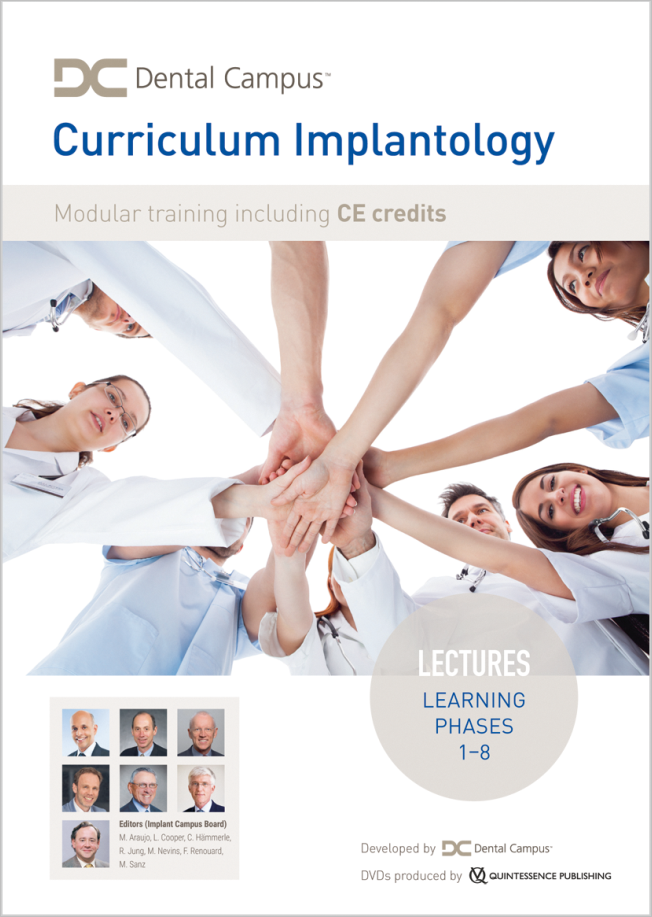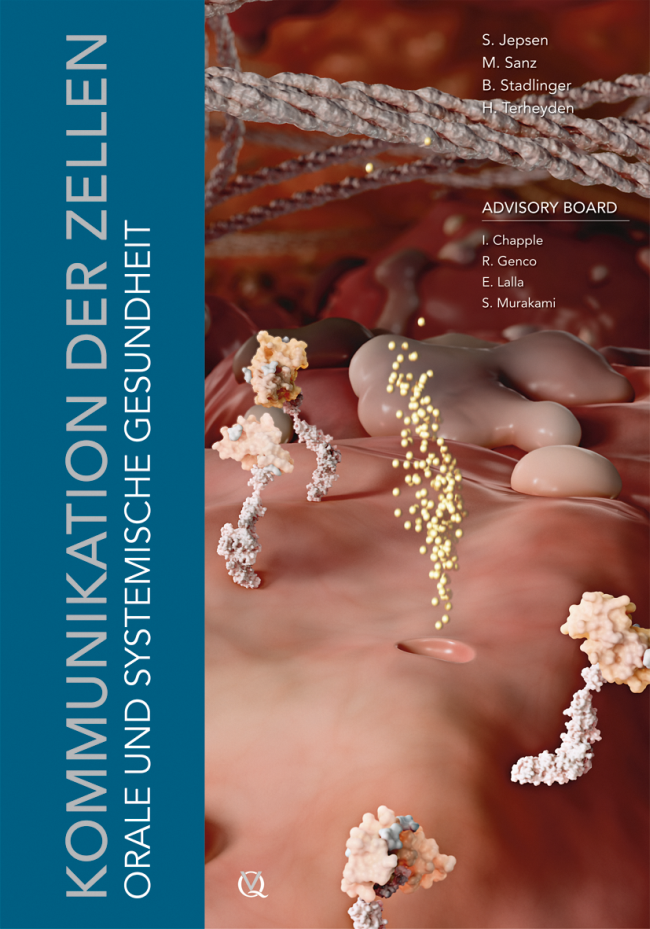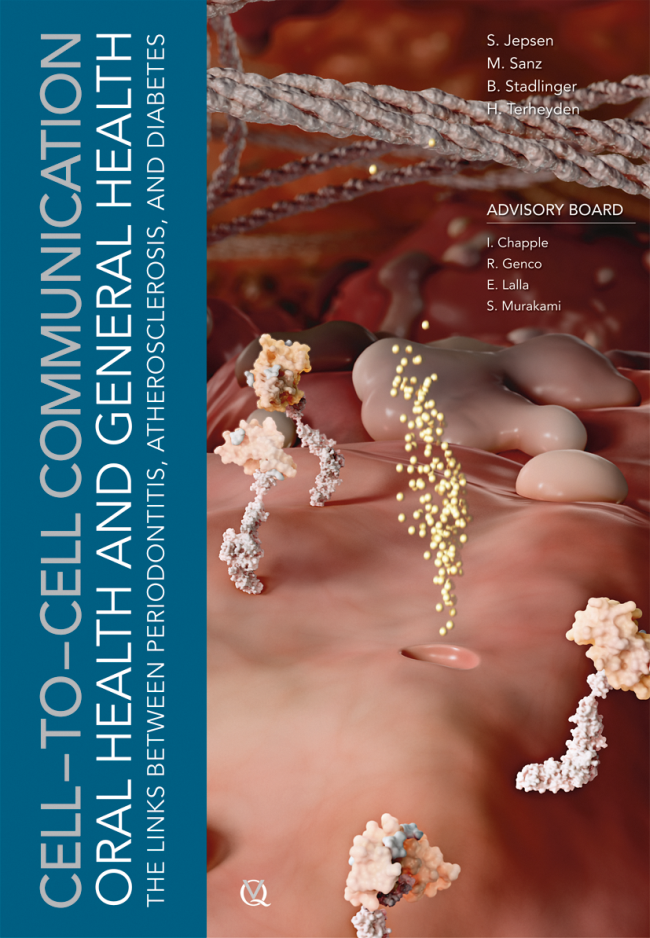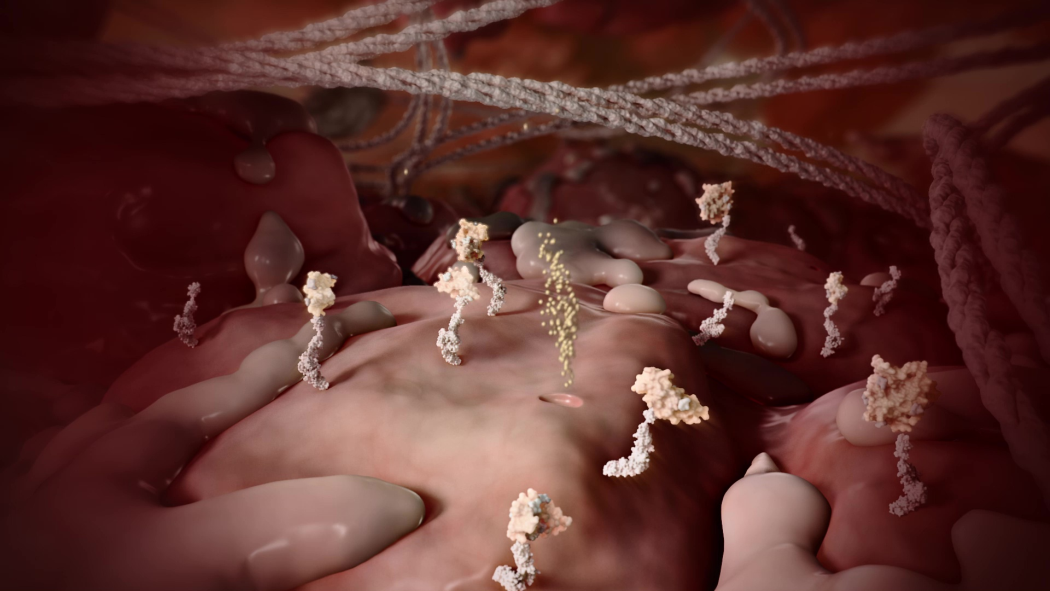International Journal of Periodontics & Restorative Dentistry, Pre-Print
DOI: 10.11607/prd.7286, PubMed ID (PMID): 392703116. Sep 2024,Pages 1-24, Language: EnglishPalombo, David / Mascetti, Tommaso / Zucchelli, Giovanni / Sanz, MarianoThe management of severe mucogingival deformities surrounding malpositioned implants represents a complex issue with a high risk of aesthetic failure. The present case report describes a mucogingival and restorative approach for the treatment of severe localized peri-implant tissue deficiencies with interproximal bone loss combined with an interproximal gingival recession on the adjacent natural tooth. This consists of maintaining a non-restorable malpositioned implant, submerging it through one or multiple vertical soft tissue augmentations, according to the defect severity, and delivering a tooth supported bridge involving the adjacent natural teeth. The step-by-step surgical technique adopted for implant submergence and vertical soft tissue grafting, as well as the subsequent surgical and prosthetic interventions, are described, presenting results at 5 years from implant submergence and 3 years from prosthetic finalization.
Keywords: Implants, Periodontal Surgery, Prosthetic Dentistry, Gingival Recession, Mucogingival Surgery, Dental Implant, Case Report
International Journal of Periodontics & Restorative Dentistry, 5/2024
DOI: 10.11607/prd.2024.5.e, PubMed ID (PMID): 39283759Pages 496-497, Language: EnglishZabalegui, Ion / Sanz, MarianoEditorial International Journal of Periodontics & Restorative Dentistry, 5/2023
DOI: 10.11607/prd.2023.5.e, PubMed ID (PMID): 37733467Pages 537-539, Language: EnglishTonetti, Maurizio S. / Heitz-Mayfield, Lisa / Papapanou, Panos N. / Sanz, MarianoEditorialConsensus on a valid and comprehensive set of outcomes to capture the full benefits and harms of implant dentistry interventions is key for progressing toward better clinical guidelines and policy. In this field, research remains fragmented and uses too many different outcomes. Studies are unable to cover the full breadth necessary to properly evaluate benefits, harms, and costs. Best-practice examples inspired the Implant Dentistry Core Outcome Set and Measurements (ID-COSM) initiative that identified four core outcome domain areas (pathophysiology, implant/prosthesis lifespan, life impact, and access to care), five essential outcomes mandatory for all trials, and six outcomes mandatory in specific circumstances. This innovative multistep approach combined input from scientific evidence, patients from multiple countries, methodologists, and industry representatives. The ID-COSM consensus aspires to contribute to better adoption of relevant and valid outcomes in trials and enable their results to be combined in high-quality meta-analyses to support better-informed care and policy.
Quintessence International, 1/2022
DOI: 10.3290/j.qi.b1763645, PubMed ID (PMID): 34269040Pages 24-34, Language: EnglishCalzavara, Dino / Morante, Segio / Sanz, Javier / Noguerol, Fernando / Gonzalez, Jerian / Romandini, Mario / Sanz, MarianoObjectives: The aim of this retrospective case series was to report the performance up to 5 years of an innovative surgical design (the apically incised coronally advanced surgical technique [AICAST]) for the regenerative treatment of one- or two-walled intrabony periodontal lesions.
Method and materials: After completion of standard step I to II periodontal therapy, nine isolated periodontal defects were treated through AICAST. The following clinical outcome measurements were collected before the surgical intervention and at the last available follow-up: probing pocket depth (PPD), recession depth (REC), and clinical attachment level (CAL). Periapical radiographs of the treated teeth were also taken at baseline and at the last available follow-up (18 months or 5 years postoperatively).
Results: A mean (± standard deviation) PPD reduction of 6.05 ± 1.76 mm (P < .01), REC reduction of 1.15 ± 1.97 mm (P = .119), and CAL gain of 7.20 ± 2.13 mm (P < .01) were attained when comparing preoperative results with the last follow-up visit. CAL gain of 6 mm or more was reached in eight out of nine treated cases (88.9%), with a residual PPD of 2 to 3 mm in all the cases. Complete radiographic fill of the intrabony component was present in all the defects, while detectable suprabony radiographic filling was identified in two cases.
Conclusion: AICAST represents an innovative surgical design for the treatment of deep intrabony defects and the eventual reduction of the associated gingival recessions. Preliminary results show good performance in terms of clinical attachment gains and maintenance of the marginal tissues.
Keywords: coronally advanced flap, enamel matrix derivatives (EMD), papilla preservation flap, periodontal regeneration, periodontitis
Oral Health and Preventive Dentistry, 1/2021
Open Access Online OnlyPeriodontologyDOI: 10.3290/j.ohpd.b875525, PubMed ID (PMID): 3349137426. Jan 2021,Pages 15-24, Language: EnglishTomšič, Katja / Rodič, Katarina / Sotošek, Anja / Videmšek, Petja / Seme, Katja / Herrera, David / Sanz, Mariano / Gašperšič, RokPurpose: To investigate the subgingival microbiological profiles of patients with periodontitis, to determine their stage and grade scores and to evaluate the differences in the microbiota among different stages and grades.
Materials and Methods: Sixty-seven (n = 67) periodontitis patients were selected. Periodontitis staging and grading, following the 2018 classification system, were defined. Following a clinical examination, subgingival samples were taken from the deepest periodontal pocket of each quadrant for cultivation, identification and quantification. The prevalence, proportion and counts of nine selected periodontal pathogens were determined, and differences between periodontitis stages III and IV and grades B and C were assessed.
Results: All nine cultivable periodontal bacteria were detected, of which the most prevalent was P. intermedia (91.0%) and the least prevalent were E. corrodens (9.0%) and C. ochracea (9.0%). The frequency of detection of the two main target pathogens, A. actinomycetemcomitans and P. gingivalis, was 41.8% and 76.1%, respectively. The prevalence (grade B: 80.6%, grade C: 55.6%, p = 0.035) and total counts (grade B: 19.8 colony forming units – CFU/ml-4 (1.9–52.8); grade C: 4.0 CFU/ml-4 (0.0–26.4); p = 0.022) of F. nucleatum were statistically significantly higher in grade B than in grade C periodontitis patients, whereas the counts of P. gingivalis and A. actinomycetemcomitans were similar between grades and stages.
Conclusion: Our study suggests that relevant differences between the various grades of periodontitis exist only in the numbers of F. nucleatum. Prevalence and quantities of other cultivable species between different stages and grades of periodontitis seem to be similar.
Keywords: periodontitis, stage, grade, Porphyromonas gingivalis, Aggregatibacter actinomycetemcomitans, Fusobacterium nucleatum
Oral Health and Preventive Dentistry, 1/2020
Open Access Online OnlyPeriodontologyDOI: 10.3290/j.ohpd.a44444, PubMed ID (PMID): 326184594. Jul 2020,Pages 363-371, Language: EnglishGraziani, Filippo / Minenna, Luigi / Karapets, Dimitra / Herrera, David / Nisi, Marco / Gennai, Stefano / Gabriele, Mario / Discepoli, Nicola / Petrini, Morena / Marhl, Urška / Perić, Marina / Adriaen, Laurence / Alonso, Bettina / Bouchard, Philippe / Cardaropoli, Daniele / Cavalcanti, Raffaele / Chackartchi, Tali / Franch-Chillida, Fernando / Gianserra, Rodolfo / Guerrero, Adrian / Landi, Luca / Masiero, Silvia / Mensi, Magda / Moratti, Paolo / Oreglia, Francesco / Rupe, Antonio / Sanchez, Ignazio / Sforza, Nicola / Capri, Diego / Zabalegui, Ion / Sanz, Mariano / Tonetti, Maurizio / Tomasi, CristianoPurpose: No information is available on the perception of the quality of care in patients treated for periodontitis. The purpose of this article was to assess how periodontitis-affected patients perceive the quality of periodontal treatment (PT) and to measure the factors which may influence it.
Materials and Methods: 306 subjects who completed PT were invited to participate. Questionnaires and visual analogic scales (VAS) evaluating perception of quality of care, symptoms, and oral health related quality of life (OHRQoL) were handed out. Oral and periodontal indicators were collected before and after treatment. The impact of different factors on perception of quality was assessed with a regression model.
Results: Quality evaluation was high yet unrelated for both patients and clinicians (p = 0.983). Quality was negatively influenced by the number of residual oral infections (p 0.001), patient's age (p = 0.07) and presence of residual pain at completion of PT (p = 0.02). Professionalism, kindness of the staff and communication skills were the characteristics mostly appreciated. The OHRQoL was influenced by the number of residual teeth (p 0.001), increasing age of patients (p = 0.08), number of residual infections (p 0.01) and pain (p = 0.04).
Conclusions: Patients' quality perception appeared to be influenced by clinical and emotional aspects. Oral care providers should be aware of the impact of non-clinical factors in patients' appreciation of quality of treatment.
Keywords: oral health related quality of life, periodontitis, quality of care
International Journal of Periodontics & Restorative Dentistry, 4/2019
DOI: 10.11607/prd.3329, PubMed ID (PMID): 29897350Pages 517-524, Language: EnglishCha, Jae-Kook / Sanz, Mariano / Jung, Ui-WonThis report presents a histologic assessment of guided bone regeneration for dehiscence defects treated with bovine bone mineral or a combination of autogenous and synthetic bone. The samples were obtained from an autopsy specimen donated by a patient, which is a rare opportunity to evaluate longterm results of guided bone regeneration and osseointegration. The values for bone-to-implant contact were similar in both sites. The augmentation with bovine bone mineral demonstrated bone reconstruction after 1 year, whereas the augmentation with autogenous and synthetic bone failed to maintain the augmented volume, eventually leading to mucosal recession after 5.5 years.
International Journal of Periodontics & Restorative Dentistry, 5/2018
DOI: 10.11607/prd.3566, PubMed ID (PMID): 30113607Pages 683-690, Language: EnglishNúñez, Javier / Sanz-Esporrin, Javier / Caffesse, Raul / Sanz, MarianoRoot coverage in the anterior mandible is challenging due to a thin gingiva, shallow vestibule, and/or high frenulum. This case series reports on the flattening of the root surface to create a new emergence profile conceived with a two-step surgical approach aimed at providing more space for the graft, increasing the thickness of the gingival margin, and getting extra soft tissue in the open area of the recession. A total of 10 patients with recessions affecting the mandibular incisors were treated to evaluate this two-step approach, which included odontoplasty of the root followed by a connective tissue graft. At 1 year, the mean coverage was 100% in Class II recessions, and 80.5% in Class III. The mean keratinized tissue increase was 5.80 ± 1.75 mm. This surgical approach could be proposed as an alternative when treating mandibular anterior teeth with root prominence or with a buccally tilted position.
International Poster Journal of Dentistry and Oral Medicine, 5/2018
SupplementPoster 1209, Language: EnglishSolonko, Myroslav / Ribeiro-Vidal, Honorato / Sánchez, Ignacio Sanz / Montero, Eduardo / Sanz, MarianoCase ReportAim: to present a case report of a prosthetically driven digital treatment planning and its subsequent execution, using the fully guided implant placement protocol, in a complex periodontal patient.
Material and Methods: A 58-year old partially edentulous female patient was referred to the post-graduate clinic of Master of Periodontology program of Complutense University (Madrid, Spain) for periodontal and implants treatment. Her chief complaint was teeth mobility, in both upper and lower jaws. After a clinical and radiographic diagnosis, the strategic decision was made to extract all maxillary teeth due to the complex treatment plan with the goal to achieve functionally stable and esthetically pleasing results. The following treatment sequence was used: all maxillary teeth were extracted in a single session, with a fabrication of an immediate removable complete denture. No socket preservation was performed. 6 weeks after teeth extraction, a CBCT was obtained, and the dental stone model of the maxilla was optically scanned. Resulting DICOM and STL files were superimposed in the SMOP Implant Planning System (Smop, Swissmeda, Zurich, Switzerland). The placement of six Conelog implants (Camlog, Biotechnologies AG, Switzerland) was planned and the surgical guide was designed for the protocol of fully-guided implant placement. After printing the surgical guide, the metal guide sleeves were inserted in the corresponding locations, and the surgery performed. Four implants were placed according to the flapless implant placement protocol, and two implants were placed with a flap elevation and simultaneous sinus floor elevation. Six months after surgery, second stage surgery on two implants was performed, and a definitive full-arch restoration was fabricated.
Conclusions: complex treatment planning using digital approach may facilitate the process of implants placement, making it more safe and predictable, and improve the long-term functional and esthetic result of the complex rehabilitation. Disclosure: Nothing to disclose.
Keywords: Full arch, delayed implant, guided surgery
International Poster Journal of Dentistry and Oral Medicine, 5/2018
SupplementPoster 1211, Language: EnglishFierravanti, Ludovica / Ambrosio, Nagore / Molina, Ana / Sanz, Ignacio / Martin, Conchita / Blanco, Juan / Sanz, MarianoAim: To compare the effect of placing the definitive abutment at the time of implant placement versus at a later stage, on the soft and hard tissue changes around dental implants.
Materials and methods: Implants were placed in the posterior maxilla or mandible of partial edentulous patients and they were randomized to receive the definitive abutment at the moment of implant placement, or 6-12 weeks later. Radiographic assessment of vertical bone level changes (RBC) (primary outcome), clinical status of peri-implant tissues, changes in soft tissues margin, papilla filling and patient-related outcomes were assessed 6, 12 and 36 months after loading.
Results: 60 implants were placed in 40 patients. In test group 9 single unit and 19 multiple unit were restored and in the control group 12 single and 19 multiple unit. 45.8% of the implants were placed in the maxilla and 54.2% in the mandible.
Overall survival rate was of 98,3% at 36 months. A tendency of greater bone loss was observed in the control group over time, being only statistically significant at 6 months. However, between 12 months and 36 months, a slight greater bone gain was observed in booth group. At 36 months the bone loss was 0.94mm vs 0.49mm in control and test respectively.
Periodontal clinical parameters (probing depth, plaque and bleeding) did not demonstrate significant differences between groups at any time point. A significant increase in papilla height was observed from loading to 36 months in both groups, with no differences between the groups.
Regarding patient-related outcomes, no differences were between test and control.
Conclusion: The one abutment - one time concept is associated with less marginal bone loss. Furthermore, peri-implant tissues stability seem to endure in the long term (3 years).
Keywords: Marginal bone level, one-abutment one-time, implants







